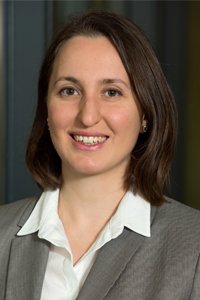Solving Unmanned Aerial Vehicle Problems

Professor Derya Aksaray’s innovative research involves solving multiple problems in the area of unmanned aerial vehicles (UAV) and the provably-correct behavior of safety of operating those vehicles in urban areas.
Professor Aksaray attempted to become a pilot. “I actually entered the examination for being a military pilot.” She states that this is how her interest began and led to her pursuit of an academic career in aerospace. After receiving her Ph.D., she moved to Boston for her first postdoc position at Boston University where she focused on verifiable control of dynamical systems.
Her postdoctoral researcher career path led her to MIT next, where she developed and expanded her research and expertise in the area of machine learning and robotics. Now in the AEM department at Minnesota, Professor Aksaray is trying to blend all of her knowledge of aerospace, robotics, machine learning, and computer science together to best serve her.
She describes her current work with autonomous systems to be similar to the way humans already react instinctively.
“As humans, we also don’t anticipate about what is going to happen around us, right? So when something happens, even if we don’t always perform in an optimized fashion, we quickly find practical solutions. We take in to account our safety considerations, like we don’t hit the wall or do something very crazy. We always come up with solutions. It’s not like I am stuck, I don’t know what to do. It’s always coming up with a solution that’s the best that you can do. So I am fascinated about that, and try to address the question of how we can bring that kind of a capability to autonomous systems,” she said.
But these systems do not currently have the necessary mechanisms that lead to guaranteed performance and safety.
“Right now the autonomous systems either rely on the human control, or are designed mission-specific. But for arbitrary missions we cannot guarantee that nothing, for example, unsafe or dangerous will happen.”
Professor Aksaray is currently working with two students to investigate different problems that relate to safe and efficient operation of heterogeneous systems, and dynamic obstacle avoidance.
“With my Ph.D. student we are working on a heterogeneous system where there are multiple UAV’s, unmanned aerial vehicles, and UGV’s, unmanned ground vehicles. If you look at small unmanned aerial vehicles, they have limited energy capacity. So if you want them to perform long duration missions, such as persistent monitoring, they have to periodically go back to the base to get charged and then continue to their mission accordingly,” she said.
Professor Aksaray and her student are considering mobile charging stations, where unmanned aerial vehicles can land on a UGV and are transported during the charging process so that the monitoring mission can be continued from another location.
“This is just bringing a lot of challenges to the problem,” Professor Aksaray said. “We are thinking about how we can find the optimal trajectories of vehicles with different capabilities so that the UAV’s will never run out of fuel, they will never crash to the ground, and then in the meantime we will also optimize the performance, for example, maximizing situational awareness.”
The other problem that Professor Aksaray is focusing on relates to dynamic obstacle avoidance. To have unmanned aerial vehicles in urban environments, it is important to make sure that these vehicles don’t pose a threat to humans and other operating autonomous vehicles.
“There will be humans around, maybe some other robots that are doing their individual missions, and before starting a mission we cannot anticipate about all possible cases because a human can just come across, or there will be something changed in the environment,” she said.
So Professor Aksaray and her student are looking to develop an algorithm that will guarantee the collision avoidance with moving objects, which can contribute to the development of the urban area mobility concept, which Professor Aksaray described as a “flying uber.”
Aside from her work in the aerospace field, she is passionate about dance. “I really like dancing, I did classical ballet for more than 10 years,” she said. “I was thinking about having a dancing school.”
But Professor Aksaray knows she made the right choice with her career. “It was nice as a hobby, but I always have excitement about math and engineering so I think I made the correct decision.”
In the future, Professor Aksaray is hoping to learn more about the intersection of machine learning, planning, and control of dynamical systems, which will potentially enable the development of resilient autonomous systems. She is also looking to enlarge her research group to address research questions related to how autonomous systems can be safely integrated into daily life, and how humans can benefit from these systems.